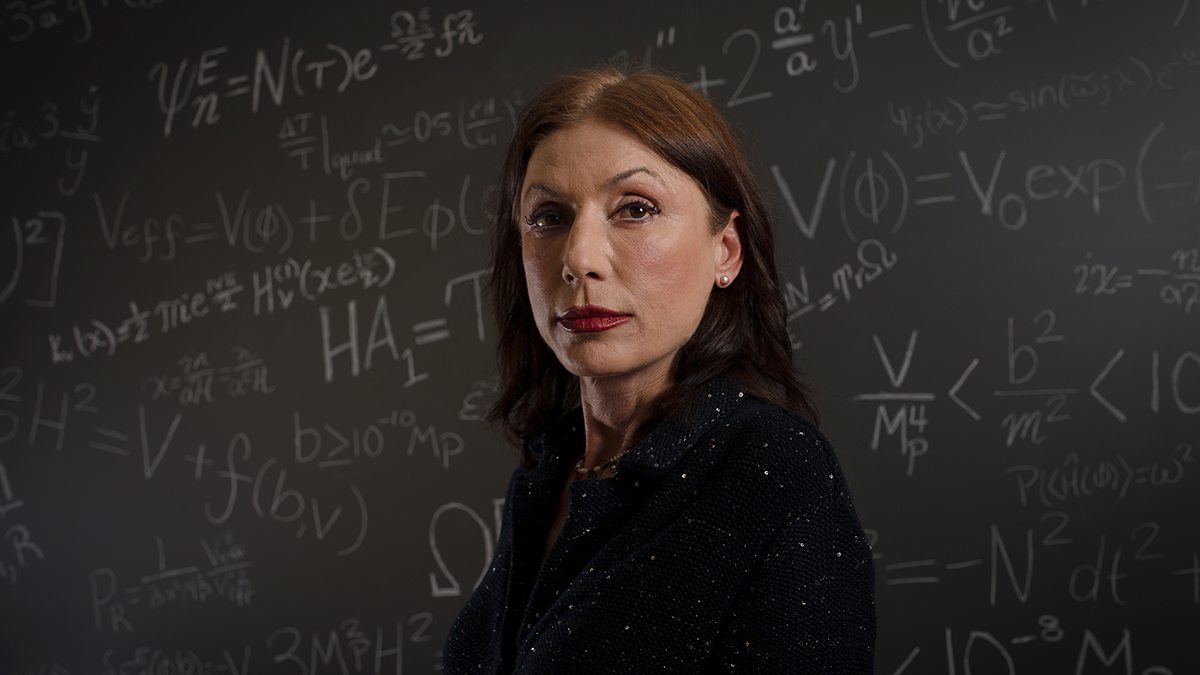An origin story
Most theoretical physicists don’t see their predictions confirmed in their lifetimes, as it can take centuries to discover the physical phenomena that marks them true. But that hasn’t been the case for Laura Mersini-Houghton, who’s seen six of her predictions about the origins of the universe verified in the last decade.

On the northern tip of Ireland, where the North Sea meets the Atlantic, waves smash into 40,000 ancient, hexagon-shaped pillars at Giant’s Causeway — the result of a volcanic eruption 60 million years ago. Small pools form in the cracks between each column. As the winds rage, the sun scorches the landscape, and a bone-chilling sweat settles over Laura Mersini-Houghton, who shifts uncomfortably. Across from her, a documentary filmmaker stands behind a video camera and asks her a question. She tries not to shiver as she replies.
“Think of these waves leaping over the rocks as the wave function of the universe trying to travel through this landscape structure. If I think of the rocks as the energy field and each pocket representing an energy valley on the landscape, as the waves come through, many will be trapped in different pockets rather than travel further. Each pocket can be a birthplace for a universe similar to ours.”
Mersini-Houghton is explaining the multiverse hypothesis. First suggested by the Ancient Greek philosopher Democritus, it is the idea that our universe is one of many formed by a Big Bang-like event — a concept that Mersini-Houghton agrees with. A Carolina cosmologist and pioneering theoretical physicist, she began studying the origin of the universe decades ago. Why? Because the probability that our universe should even exist is basically zero, according to Mersini-Houghton. “The chances are 1 in 10 with 123 zeroes behind it, so pretty much zero.”
In 2005, Mersini-Houghton had a curious idea. A frequenter of coffee shops, she sat in quiet contemplation at the Starbucks on Franklin Street, staring thoughtfully at her pen and pad on the table. She began to think about the mathematical representation of the universe, which forms a wave, and spent hours lost in thought over it.
Then something clicked: What if she combined the physics of string theory (the idea that matter and energy are composed of tiny, vibrating strings) with those of quantum mechanics (how matter and light behave at microscopic levels)? She used the former to manipulate the wave, and after calculating how that waveform evolves, she found that the result is many universes — each with their own properties and constants — and one high-energy Big Bang. To the average mind, the process sounds complex, but to Mersini-Houghton, “it’s so simple that it’s too simple,” she chuckles.
After taking more time to work out the problem, Mersini-Houghton developed her first calculation for the origin of the universe. “We got the correct answer theoretically for the first time in science,” she said. “Before then, we hadn’t been able to derive an answer to the origin of the universe. That gave me hope to check for predictions to test that theory. But getting the right answer does not guarantee what nature does. What does nature care about some theory I cooked up?”
Although Mersini-Houghton is not the first person to support a multiverse hypothesis, she is the first to successfully derive the answer from basic physics principles and live in a time when there’s physical observations that support it.
The same sky
If other universes exist, then those closest to our own would exert a gravitational tug, causing matter to shift. Think of it like a piece of fabric. Pull on it from both sides and it begins to stretch. Continue tugging on it and, over time, a hole forms. For Mersini-Houghton, this meant that, somewhere in our universe, there should be a void. A big one.
“The sky we observe today is just a blown-up version of the sky from 14 billion years ago,” she explained. “So whatever happened in the universe’s infancy — it’s still there somewhere in our sky. And we can track it down.”
In August 2007, University of Minnesota physicist Lawrence Rudnick did just that — accidentally. While studying data from the NRAO VLA Sky Survey, he discovered an abysmal hole, nearly a billion light-years across, containing virtually no matter. And it was located in the region Mersini-Houghton and her collaborators first predicted it would be in 2006.
“We got lucky,” she admits. “It was first observed accidentally only seven months after we predicted it. It caused huge fights in the astrophysics community about whether those observations were correct or not.”
Data from the Wilkinson Microwave Anisotropy Probe (WMAP) satellite helped verify the void’s presence. The satellite measures temperature fluctuations throughout the universe, and the hole’s location runs cold. But it wasn’t until 2015, after using a more precise satellite called Planck, when the cold spot’s existence was officially recognized and confirmed.
“I was in the right place at the right time,” Mersini-Houghton said. “When I was working on these predictions I thought we would not have these observations in my lifetime. They’re challenging our understanding of the universe — and we cannot brush them under the rug.”




